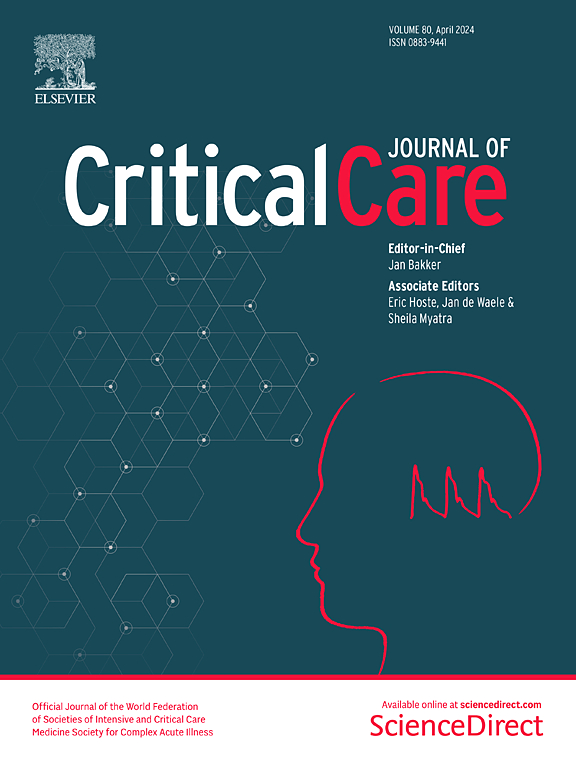Trajectories of fluid management after the initiation of renal replacement therapy in critically ill patients: a secondary analysis of the STARRT-AKI trial
IF 8.8
1区 医学
Q1 CRITICAL CARE MEDICINE
引用次数: 0
Abstract
Fluid management is an essential component of renal replacement therapy (RRT) in critically ill patients. Both a positive cumulative fluid balance (CFB) and a high net ultrafiltration (NUF) rate have been reported to be associated with adverse outcomes in epidemiological studies, although the overall trajectory of fluid balance after RRT initiation is not well-described. We aimed to characterize trajectories of fluid management parameters during RRT and analyse the effect of CFB/NUF on outcomes as a trajectory rather than single or aggregated time points over the first week after initiation of RRT. This is a secondary analysis using fluid balance data focusing on individuals enrolled in the standard-strategy arm of the STARRT-AKI trial who initiated RRT. Cumulative fluid balance (CFB) following RRT initiation and daily net ultrafiltration (NUF) adjusted for body weight during the first 7 days after initiation of RRT were the main independent exposures. We modeled the trajectory of fluid parameters using spline functions and used latent trajectory analysis methods to identify predominant trajectories to compare patients’ characteristics and outcomes. We employed logistic regression and multivariable joint longitudinal models to compare the odds and determine the time-dependent association between fluid parameters (CFB and NUF) and 90-day mortality across and within the trajectory classes identified. We included 855 patients in the primary analysis. After excluding erroneous fluid balance data, we identified two distinct CFB/NUF trajectories. Class A (82.8%) was characterized by a slight increase in CFB and low/stable NUF during the week following RRT initiation while class B (17.2%) was characterized by an increasingly negative CFB with initially higher daily NUF during the first 4 days followed by a stabilization after day 4. In an adjusted analysis, individuals classified in class B were at lower risk for 90-day mortality (aOR: 0.48 CI 0.32; 0.70) p < 0.001) compared to class A. Time-dependent analysis revealed higher CFB was associated with mortality only in those with a class A trajectory (aHR 1.29, 95% CI 1.03–1.55, p = 0.03). Distinct CFB/NUF trajectories convey prognostic information beyond single-day fluid balance or NUF values and should be considered when formulating or interpreting fluid management strategies.危重患者开始肾脏替代治疗后的液体管理轨迹:对STARRT-AKI试验的二次分析
液体管理是危重患者肾替代治疗(RRT)的重要组成部分。在流行病学研究中,尽管RRT开始后体液平衡的总体轨迹尚未得到很好的描述,但据报道,正累积体液平衡(CFB)和高净超滤(NUF)率都与不良结果相关。我们的目的是表征RRT期间流体管理参数的轨迹,并分析CFB/NUF在RRT开始后第一周内作为轨迹而不是单个或聚合时间点对结果的影响。这是一项使用体液平衡数据的二次分析,重点关注参加STARRT-AKI试验标准策略组并启动RRT的个体。RRT开始后的累积体液平衡(CFB)和RRT开始后最初7天内根据体重调整的每日净超滤(NUF)是主要的独立暴露。我们使用样条函数对流体参数的轨迹进行建模,并使用潜在轨迹分析方法来确定主要轨迹,以比较患者的特征和结果。我们采用逻辑回归和多变量联合纵向模型来比较概率,并确定流体参数(CFB和NUF)与90天死亡率之间的时间依赖关系。我们在初步分析中纳入了855例患者。在排除了错误的流体平衡数据后,我们确定了两种不同的CFB/NUF轨迹。A类(82.8%)的特征是在RRT开始后的一周内CFB轻微增加和低/稳定的NUF,而B类(17.2%)的特征是CFB越来越负,最初4天内每日NUF较高,第4天后趋于稳定。在一项校正分析中,B类个体的90天死亡率风险较低(aOR: 0.48 CI 0.32;0.70) p < 0.001)。时间依赖性分析显示,较高的CFB仅与a类患者的死亡率相关(aHR 1.29, 95% CI 1.03-1.55, p = 0.03)。不同的CFB/NUF轨迹传递的预后信息超出了单日流体平衡或NUF值,在制定或解释流体管理策略时应予以考虑。
本文章由计算机程序翻译,如有差异,请以英文原文为准。
求助全文
约1分钟内获得全文
求助全文
来源期刊

Critical Care
医学-危重病医学
CiteScore
20.60
自引率
3.30%
发文量
348
审稿时长
1.5 months
期刊介绍:
Critical Care is an esteemed international medical journal that undergoes a rigorous peer-review process to maintain its high quality standards. Its primary objective is to enhance the healthcare services offered to critically ill patients. To achieve this, the journal focuses on gathering, exchanging, disseminating, and endorsing evidence-based information that is highly relevant to intensivists. By doing so, Critical Care seeks to provide a thorough and inclusive examination of the intensive care field.
 求助内容:
求助内容: 应助结果提醒方式:
应助结果提醒方式:


